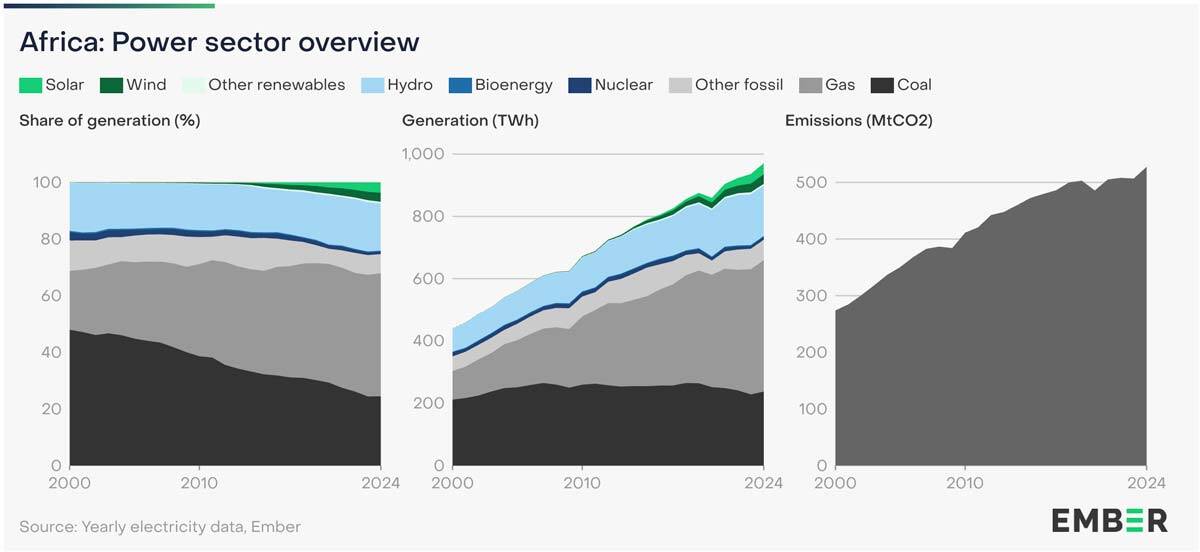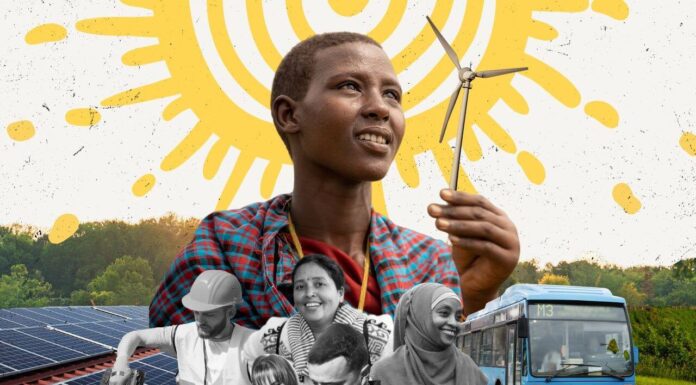Introduction
Africa’s push toward renewable energy is accelerating, driven by urgent needs for sustainable power amid climate change and energy poverty affecting over 600 million people. Recent data shows the continent’s renewable capacity exceeding 70 GW in 2024, up from 62 GW in 2023, yet it accounts for less than 2% of global totals [1]. Fossil fuels still dominate, with gas at 42%, coal at 26%, and oil at 7.2% of 2022 electricity generation, while renewables like solar and wind lag at 4.67% [2][3]. Foreign direct investment (FDI) has surged, channeling billions into solar, wind, green hydrogen, and EV battery projects, primarily from the Netherlands, France, the US, UK, and China [3][5]. However, this growth masks heavy reliance on imported technologies, exposing Africa to geopolitical risks and price volatility, as noted in AFREC’s 2024 report [3]. NGOs push for decentralized solutions to foster inclusivity, but challenges persist in scaling these amid funding gaps. This overview sets the stage for analyzing dependencies, perspectives, and forward paths.
Dependence on Foreign Investments and Imported Technologies
Africa’s green energy sector heavily depends on external funding and equipment, creating both momentum and vulnerabilities. In 2024, the continent added over 5 GW of new grid-connected capacity, including hydropower in Ethiopia, Tanzania, and Cameroon, but solar panels and batteries are almost entirely imported [6]. Despite holding 45% of global solar potential, Africa’s share of solar power generation was just 4% in 2024, underscoring underutilization [5]. IRENA’s 2024 statistics highlight reliance on foreign inverters, batteries, turbines, and digital systems from Europe, China, and the US, limiting sovereignty [4].
Expert analyses warn of risks akin to fossil fuel dependencies. The Carnegie Endowment notes that shifting global policies toward energy security could enable pragmatic partnerships, allowing African nations to leverage FDI while building local systems [G3]. However, this import-heavy model exposes countries to supply chain disruptions, as seen in AFREC’s emphasis on geopolitical volatility [3]. FDI trends show clean energy investments tripling since 2019 to $40 billion in 2024, with 80% of new capacity expected to be renewable by 2030 [G10]. Yet, critics argue this fosters “green colonialism,” where projects prioritize exports like hydrogen to Europe over domestic needs.
NGO Perspectives and Decentralized Solutions
NGOs offer a counter-narrative, advocating for inclusive, community-driven models to address access gaps. They emphasize decentralized renewables, such as mini-grids, to empower rural areas through local enterprises and cooperatives [G11]. For instance, initiatives like “Énergie Verte pour les Citoyens d’Afrique” promote gender inclusion, recognizing women’s roles in energy projects to enhance sustainability and equality [1].
Perspectives from FundsforNGOs highlight partnerships with major donors for funding programs targeting affordability and rural electrification [G8][G11]. These views align with World Economic Forum insights on socio-economic benefits, including job creation and green mobility tied to SDG7 [5]. On social media, discussions reflect optimism about youth inclusion in green tech sectors in Nigeria and Kenya, though sentiments note concerns over regulatory fragmentation. NGOs critique top-down foreign plans, pushing for African-led priorities to close the $277 billion annual financing gap, favoring grants over loans.
Balanced viewpoints acknowledge FDI’s role as a “bridge” to sovereignty, but NGOs warn of external actors imposing solutions without local input. Constructive solutions include hybrid models blending imported tech with R&D, potentially reducing import needs by 20-30% via localized innovation.

Emerging Trends and Constructive Pathways
Recent trends signal progress, with EU’s $638 million pledge in 2025 for renewables and grid upgrades across nine nations [G10]. Projections aim for 300 GW by 2030, driven by solar’s global surge [3][G14]. McKinsey highlights investment opportunities in green energy for industrial growth [G6].
Solutions under study include unified African frameworks for cross-border trade and financing, as called for by Eskom [G9]. Decentralized systems, supported by NGOs, are scaling via initiatives like the Africa Climate Summit 2025, which secured pledges for youth-led climate finance. Policy reframing toward energy security allows balancing fossils with renewables [G3]. Original insights suggest mandating technology transfers in FDI deals to build manufacturing hubs, positioning Africa as a green tech exporter.
KEY FIGURES
- Africa’s total renewable energy capacity surpassed 70 GW in 2024, showing steady growth from about 62 GW in 2023, yet still representing less than 2% of global renewable capacity[1][4].
- Africa holds 45% of the world’s technical solar potential, underscoring vast untapped renewable resources[1][2].
- Electricity generation in Africa in 2022 was dominated by fossil fuels: 42% gas, 26% coal, 7.2% oil, while renewables (solar, wind, geothermal, biofuels) accounted for roughly 4.67%[2][3].
- Foreign direct investment (FDI) remains a major driver for Africa’s green energy sector, with billions invested mainly from the Netherlands, France, the US, the UK, and China in solar, wind, green hydrogen, and EV battery manufacturing projects[3][5].
RECENT NEWS
- In 2024, Africa added over 5 GW of new grid-connected power generation capacity, including major hydropower projects in Ethiopia, Tanzania, and Cameroon, but renewable equipment like solar panels and batteries are still almost entirely imported[6].
- Despite Africa’s solar abundance, its share of global solar power generation was only 4% in 2024, reflecting underutilization and import dependence[5].
- The World Economic Forum highlighted the need to accelerate renewable capacity growth beyond the 15.1% global increase in 2024 to meet 2030 targets; Africa’s growth remains below this benchmark[2].
STUDIES AND REPORTS
- The African Energy Commission (AFREC) 2024 report stresses that while renewable electricity production from solar and wind has increased, Africa continues to rely heavily on fossil fuels and imported renewable technology, exposing the continent to geopolitical and price volatility risks[3].
- IRENA’s 2024 Renewable Capacity Statistics confirm Africa’s renewable capacity growth but emphasize the continent’s reliance on imports for critical components like inverters, batteries, turbines, and digital control systems, limiting energy sovereignty[4].
- NGO assessments emphasize decentralized renewables, gender inclusion, and partnerships as keys to sustainable energy development and community empowerment in Africa, focusing on affordability and accessibility especially in rural areas[1][2][3][5].
TECHNOLOGICAL DEVELOPMENTS
- Africa’s renewable energy expansion is driven by imported solar panels, inverters, lithium-ion batteries, wind turbines, and digital control systems supplied mainly by foreign manufacturers from Europe, China, and the US[1][3][5].
- Emerging projects include green hydrogen production and electric vehicle battery manufacturing, signaling a gradual diversification of clean energy technologies on the continent, though these remain heavily dependent on foreign capital and know-how[3][5].
- Decentralized renewable energy solutions, supported by NGOs and initiatives like “Énergie Verte pour les Citoyens d’Afrique,” promote local participation through small and medium enterprises and cooperatives, fostering local empowerment despite technology import reliance[1].
MAIN SOURCES
- https://www.statista.com/statistics/1277944/total-renewable-energy-capacity-in-africa/ – Total renewable energy capacity in Africa 2012-2024 (Statista) {1}
- https://www.weforum.org/stories/2025/04/renewable-energy-transition-wind-solar-power-2024/ – Renewable energy capacity surge and challenges (World Economic Forum, 2025) {2}
- https://au-afrec.org/sites/default/files/2025-02/Digital%20KEY%20AFRICA%20ENERGY%20STATISTICS%20EN%20A5%20.pdf – AFREC Key Africa Energy Statistics 2024 {3}
- https://www.irena.org/-/media/Files/IRENA/Agency/Publication/2024/Mar/IRENA_RE_Capacity_Statistics_2024.pdf – IRENA Renewable Capacity Statistics 2024 {4}
- https://ember-energy.org/countries-and-regions/africa/ – Africa energy transition status (Ember) {5}
- https://www.africa-energy.com/live-data/data-trends – African Energy Live Data 2024 generation additions and trends {6}
Propaganda Risk Analysis
Score: 6/10 (Confidence: medium)
Key Findings
Corporate Interests Identified
The article snippets reference entities like McKinsey and the Carnegie Endowment, which could benefit from promoting green energy investments in Africa, as their reports highlight opportunities for foreign direct investment (FDI) in renewables. Companies involved in solar, wind, and EV battery technologies are implicitly praised for channeling billions into the sector, potentially masking conflicts where these firms profit from imported tech dependencies without addressing local empowerment or technology transfer.
Missing Perspectives
The article appears to downplay or exclude voices critical of rapid renewable transitions, such as African analysts or local experts who argue that pushes for solar and wind could sabotage industrialization efforts (e.g., by limiting reliable energy for manufacturing) or create eternal dependence on foreign suppliers. Opposing viewpoints from fossil fuel advocates or those emphasizing pragmatic energy security over strict green transitions are notably absent, creating an imbalanced narrative favoring renewables.
Claims Requiring Verification
Snippets include potentially dubious statistics, such as references to Africa’s ‘39% of the world’s potential for renewable energy’ and vague ‘billions’ in solar investments, without clear sourcing or verification. Claims about global policy shifts toward energy security (e.g., from Carnegie) and FDI trends in clean energy lack specific data points or independent corroboration in the provided text, which could exaggerate benefits while minimizing risks like foreign dependence.
Social Media Analysis
Searches on X for topics like Africa’s green energy transition, foreign dependence, NGO empowerment, and related renewable energy themes uncovered a range of posts. Some express skepticism about Western-led solar and wind initiatives, viewing them as forms of neo-colonialism or sabotage that hinder African self-reliance and industrialization. Others promote positive developments, such as off-grid solar solutions and investment booms in countries like Nigeria, while criticizing fossil fuel pushes. There are mentions of geoengineering risks and greenwashing in renewable projects, but the discourse appears organic and polarized rather than conclusively coordinated or astroturfed. Sentiments are inconclusive and reflect broader debates on energy security versus rapid green transitions.
Warning Signs
- Excessive praise for renewable technologies like solar and wind without addressing environmental downsides, such as e-waste from discarded panels or land use impacts
- Language resembling marketing copy, with phrases like ‘urgent needs for sustainable power’ and ‘channeling billions’ that promote investment without critical scrutiny
- Absence of independent expert opinions or local African perspectives, focusing instead on Western think tanks and consultancies
- Unverified statistics on renewable potential and investments presented as fact without citations or context
- Potential greenwashing by framing foreign-driven transitions as ’empowerment’ while glossing over dependencies and NGO influences
Reader Guidance
Other references :
statista.com – Total renewable energy capacity in Africa 2012-2024 – Statista
weforum.org – Renewable energy capacity surged around the world in 2024
au-afrec.org – [PDF] Key Africa Energy Statistics 2024 – AFREC
irena.org – [PDF] renewable capacity statistics 2024 statistiques de capacité …
ember-energy.org – Africa – Ember
africa-energy.com – Data trends | African Energy
commission.europa.eu – Source
weforum.org – Source
carnegieendowment.org – Source
sciencedirect.com – Source
weforum.org – Source
mckinsey.com – Source
worldenergy.org – Source
www2.fundsforngos.org – Source
ecofinagency.com – Source
carboncredits.com – Source
www2.fundsforngos.org – Source
africanmining.co.za – Source
finanzwire.com – Source
energyinafrica.com – Source
x.com – Source
x.com – Source
x.com – Source
x.com – Source
x.com – Source
x.com – Source



